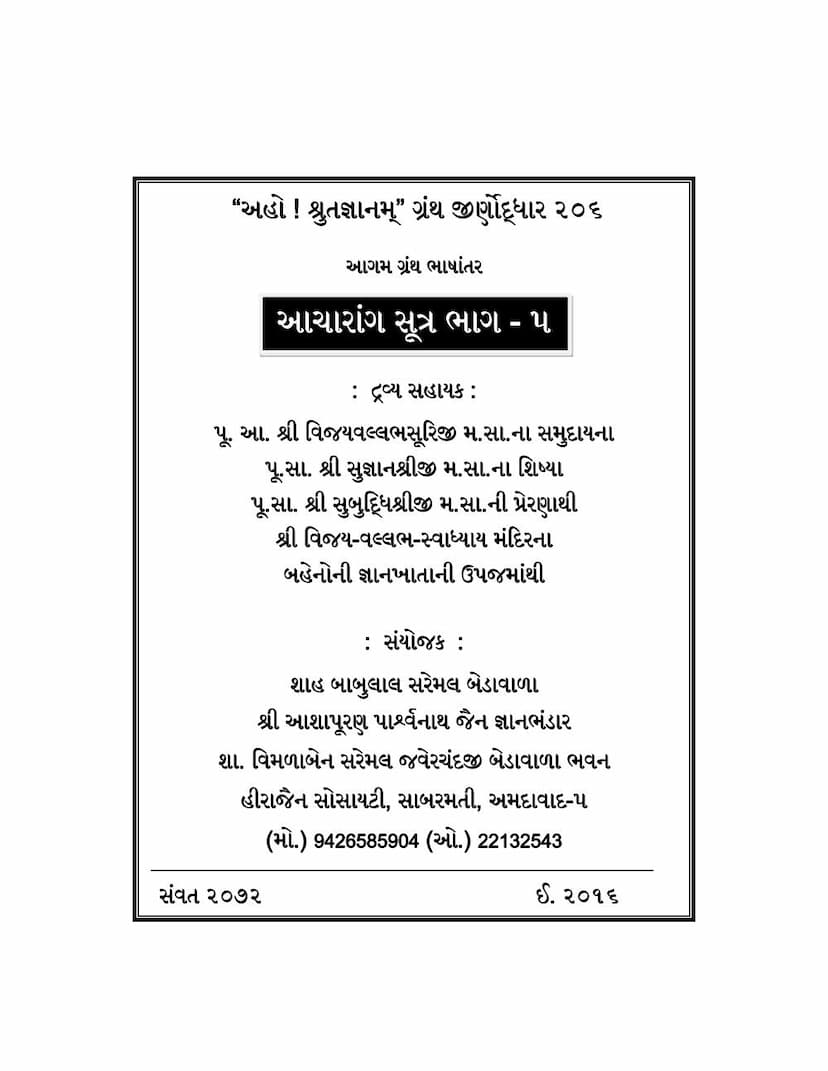Acharanga Sutra Part 05
Added to library: September 1, 2025

Summary
This is a comprehensive summary of the provided Jain text, "Acharanga Sutra Part 05," based on the Gujarati content, focusing on its essence and key themes.
Book Title: Acharanga Sutra Part 05 Author: Muni Manek Publisher: Mohanlal Jain Shwetambar Gyanbhandar Catalog Link: https://jainqq.org/explore/034253/1
Overall Focus:
This part of the Acharanga Sutra, as indicated by the preface and the content summary, focuses on the detailed practices and ethical guidelines for Jain monks and nuns. It delves into the nuances of their daily conduct, emphasizing the importance of right conduct (Achar), meticulous adherence to vows (Vrata), and cultivating spiritual discipline (Samyama). The text primarily covers the second Khanda (part) of the Acharanga Sutra, concluding it, and then extensively discusses the "Chulikas" or supplementary sections that elaborate on specific aspects of monastic life.
Key Themes and Content Summary:
The provided text is a detailed index and partial translation of the Acharanga Sutra, Part 5. It is a compilation of various Jain scriptures and their commentary, compiled by Muni Manek. The document primarily serves as a catalog and guide to these texts, rather than a narrative summary of a single continuous discourse. However, based on the structure and content, we can identify the following key areas covered in relation to the Acharanga Sutra and Jain monastic conduct:
1. Acharanga Sutra - Elaboration and Sections:
- Second Khanda and Conclusion: The text mentions that Part 5 concludes the second Khanda of the Acharanga Sutra.
- Chulikas (Supplementary Elaboration): A significant portion of the text is dedicated to explaining the concept of "Chulikas" or supplementary discussions. These Chulikas are presented as expansions on the original Acharanga Sutra, providing deeper insights and clarifications on various topics. The text details the structure of these Chulikas, with references to the number of lectures (Uddesh) and their specific content.
- Niyukti and Commentary: The importance of "Niyukti" (commentaries and elaborations by āchāryas) is highlighted, indicating that the interpretation and understanding of the Sutras rely heavily on these commentaries.
2. Monastic Conduct and Discipline (Key Areas):
The core of the text, as evidenced by the detailed breakdown of lectures and their themes, revolves around the rigorous discipline and ethical conduct expected of Jain ascetics. This includes:
- Aeshana (Proper Acquisition/Usage):
- Pinda Aeshana (Alms-receiving): This is a central theme, with extensive discussion on what kind of food is permissible or impermissible, the conditions under which it can be accepted, the defects to avoid (like impurity, admixture of life, etc.), and the proper way of receiving alms.
- Vastra Aeshana (Clothing Usage): Guidelines are provided on the types of cloth, their usage, when and how they can be acquired or used, and the conditions under which they are permissible or impermissible.
- Patra Aeshana (Vessel Usage): Similar to clothing, rules regarding the use of vessels, their purity, and the materials they can be made from are detailed.
- Shayana Aeshana (Dwelling/Resting Place Usage): This section discusses the selection of appropriate places to stay, avoiding impure or unwholesome locations, and the rules for occupying and using them.
- Water Usage: Specific rules for acquiring and using water are outlined, emphasizing purity and avoiding any violation of life principles.
- Shravaka (Lay Follower) Interaction: The text touches upon interactions with lay followers, including the proper conduct when accepting alms or offerings from them, and the importance of maintaining a detached demeanor.
- Abhigraha (Specific Vows/Undertakings): The concept of specific vows undertaken by ascetics is mentioned, indicating the depth of their commitment to discipline.
- Sthana and Nisiithika (Place and Night Conduct): Detailed rules are given for selecting and using places for contemplation (Sthana) and for conduct during the night (Nisiithika), emphasizing the avoidance of harm to living beings.
- Language and Speech (Bhasha Jata): A significant portion is dedicated to the principles of right speech, outlining what to say and what not to say, emphasizing the importance of avoiding harsh, deceitful, or harmful language, and promoting truthful, measured, and beneficial speech. This includes detailed categorization of speech.
- Prakriya (Practices and Processes): The text details various practices and processes monks and nuns must follow, from walking and observing conduct (Irya Samiti) to selecting food and places of stay.
- Dealing with External Factors: The text also addresses how ascetics should conduct themselves in various situations, such as dealing with dangerous animals, societal conflicts, improper conduct of others, and the importance of maintaining equanimity.
- Mahavrata and Bhavana (Great Vows and Contemplations): The text emphasizes the cultivation of inner qualities and spiritual contemplation (Bhavana) to support the practice of the Great Vows (Mahavrata), such as non-violence, truthfulness, non-stealing, celibacy, and non-possession. It highlights the five Bhavanas related to each Mahavrata.
- Spandila (Place for Excretion): Detailed guidelines are provided on selecting and using places for bodily excretions, prioritizing purity and the avoidance of harm to life.
- Mahavir Swami's Life: The text includes a biographical account of Lord Mahavir, his birth, his practices, and his attainment of Kevala Jnana (omniscience). This section serves as an illustrative example of the principles discussed.
3. Catalog of Texts:
The document, starting from page 2, also functions as a catalog of various Jain scriptures and related works that have been digitized or are available through the "Aho Shrutgyanam Granth Jirdodhar" initiative. This catalog lists titles, authors, commentators, and page numbers, indicating a broad range of Jain literature being preserved and made accessible. This part of the text is crucial for understanding the context of the Acharanga Sutra within the larger Jain canon.
In essence, "Acharanga Sutra Part 05" (as presented in this catalog and summary) is a vital resource for understanding the practical and ethical framework of Jain monasticism, meticulously detailing the principles that guide the daily life and spiritual journey of ascetics, with a strong emphasis on non-violence, self-control, and detachment.